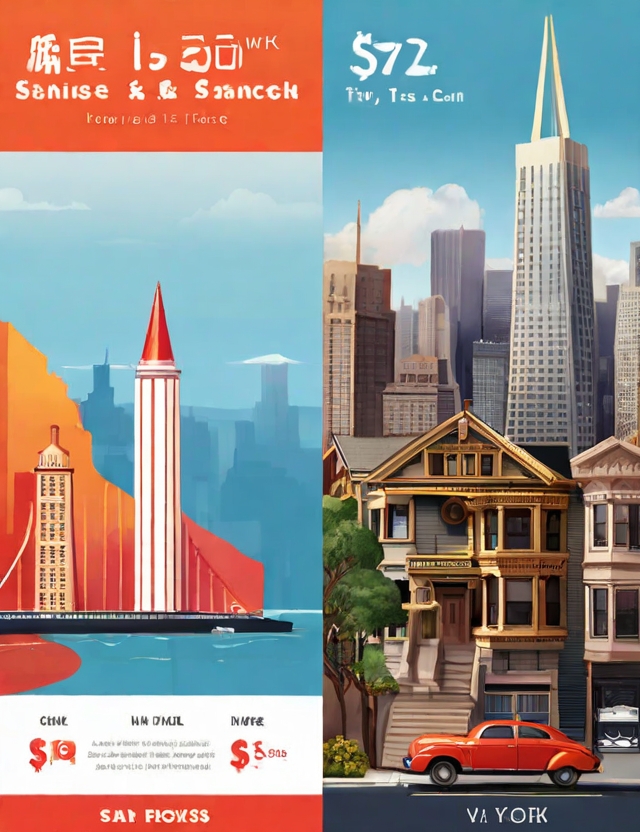
San Francisco and New York are two of America’s most iconic cities, known for their bustling energy, diverse cultures, and ample opportunity. Yet, for those hoping to live in these destinations, understanding the cost of living is critical. Whether you’re looking to move for work or personal reasons, it’s essential to understand the financial aspects of living in these cities.
Key Takeaways
- Living in San Francisco and New York can be costly.
- Housing expenses tend to be high in both cities.
- The cost of food and groceries varies depending on the location and your dietary preferences.
- Transportation costs can add up, particularly in San Francisco, where many residents rely on public transportation.
- Various miscellaneous expenses, such as healthcare and entertainment, can also contribute significantly to the overall cost of living.
Housing Costs: San Francisco vs New York
When it comes to housing costs, San Francisco and New York are two of the most expensive cities in the United States. In San Francisco, the median home price is around $1.4 million, and the average rent for a one-bedroom apartment is around $3,500 per month. Meanwhile, in New York, the median home price is approximately $680,000, and the average rent for a one-bedroom apartment is around $3,000 per month.
The availability of affordable housing options varies between the two cities. In San Francisco, there is a severe shortage of affordable housing, leading to high rent and home prices. However, in New York, there are more options for affordable housing, such as rent-controlled apartments for low-income residents.
It’s important to note that housing costs can vary significantly depending on the neighborhood and the type of housing. For example, while San Francisco’s prices are notoriously high, certain neighborhoods may offer more affordable options. Similarly, in New York, there may be more reasonably priced options in the outer boroughs compared to Manhattan.
Overall, housing costs in both cities are a significant expense. If you are considering relocating to San Francisco or New York, it’s crucial to factor in these expenses when creating your budget.
Food and Groceries: San Francisco vs New York
When it comes to food and groceries, both San Francisco and New York are known for their diverse options and high prices. In San Francisco, the cost of food and groceries can vary depending on the neighborhood, with some areas being more expensive than others. On the other hand, New York is well-known for its iconic food scene, which can be a pricey indulgence.
When it comes to grocery shopping, the prices of common food items such as fruits, vegetables, and meat products are relatively comparable in both cities. However, dining out in San Francisco can be much more expensive than in New York, with most restaurants charging at least $15 per dish.
Overall, the cost of food and groceries in both San Francisco and New York can be high but manageable if you plan accordingly and opt for cost-effective options such as cooking at home. It’s essential to factor in these expenses when budgeting for your cost of living in either city.
Transportation Expenses: San Francisco vs New York
One of the top expenses to consider when moving to a new city is transportation. In both San Francisco and New York, there are a variety of transportation options available, but let’s take a closer look at the costs associated with each:
Public Transportation
- In San Francisco, the Bay Area Rapid Transit (BART) system is a popular mode of public transportation, with a single ride costing around $3.50. Monthly passes range from $81 to $367, depending on the distance traveled.
- New York City’s Metropolitan Transportation Authority (MTA) offers an extensive subway and bus system, with a single ride costing $2.75. Monthly passes range from $127 to $264, depending on the type of pass and whether it includes commuter rail services.
Based on these prices alone, it seems that San Francisco’s BART system is more expensive than New York’s MTA. However, the distance traveled and type of pass purchased can greatly impact the total cost.
Gas Prices
If you plan on owning a car in either city, it’s important to consider the cost of gas:
- The average cost of gas in San Francisco is around $4.00 per gallon.
- The average cost of gas in New York is slightly lower, at around $3.00 per gallon.
Keep in mind that the price of gas can fluctuate depending on various factors, such as the time of year and location within the city.
Vehicle Ownership Expenses
In addition to gas, owning a car also comes with other expenses:
- In San Francisco, you can expect to pay an annual registration fee of around $120, and car insurance can cost anywhere from $800 to $1,500 per year.
- In New York, annual registration fees range from $26 to $140, and car insurance can cost anywhere from $1,000 to $2,600 per year.
Overall, it seems that owning a car is more expensive in San Francisco compared to New York, likely due to higher insurance costs.
Miscellaneous Expenses: San Francisco vs New York
When examining the cost of living in San Francisco and New York, it’s essential to take miscellaneous expenses into account. These expenses can vary widely and consist of healthcare costs, utilities, entertainment expenses, and other miscellaneous spending categories.
Heathcare costs in San Francisco and New York can be pricey. However, it is essential to understand that healthcare coverage may differ significantly in both cities. For instance, San Francisco has a universal healthcare program, “Healthy San Francisco,” that provides healthcare access to all residents, including undocumented immigrants.
Utilities can also add up in both cities, with San Francisco having higher electricity bills, while New York has higher water and sewer bills. Entertainment expenses like going to the movies, attending live shows, and other events are more expensive in New York compared to San Francisco, where the cost of entertainment is slightly affordable.
When looking at other miscellaneous expenses like personal care items and clothing, San Francisco’s cost is higher than that of New York, with personal care items often costing up to 10% more. On the other hand, clothing is cheaper in San Francisco, where it is less expensive by 5-10% compared to New York.
Overall, numerous miscellaneous expenses contribute to the cost of living in both San Francisco and New York, making it vital to budget for everyday spending in these iconic cities.
Conclusion
After analyzing the cost of living in San Francisco and New York, it is clear that both cities have their unique advantages and challenges. San Francisco has a vibrant tech scene, while New York has a diverse cultural landscape. However, the cost of living in these iconic cities can be high.
The housing costs in both San Francisco and New York are among the highest in the country. Rental and home prices are steep, and affordable housing options can be limited. Meanwhile, food and groceries are also expensive, with dining out costs adding up quickly.
Transportation expenses vary depending on the mode of transportation. While public transportation costs are relatively affordable in both cities, vehicle ownership expenses, such as gas prices, can be high.
Miscellaneous expenses such as healthcare costs, utilities, and entertainment expenses also contribute to the overall cost of living in San Francisco and New York.
Ultimately, when choosing between San Francisco and New York, it is important to consider your financial situation and lifestyle preferences. By understanding the various expenses associated with living in each city, you can make informed decisions about where to live.
Whether you choose San Francisco or New York, planning and budgeting ahead of time can help you manage the cost of living and enjoy everything these iconic cities have to offer.
FAQ
What factors should I consider when comparing the cost of living between San Francisco and New York?
When comparing the cost of living between San Francisco and New York, it’s important to consider various factors such as housing costs, food and groceries, transportation expenses, and miscellaneous expenses like healthcare and utilities.
Are housing costs higher in San Francisco or New York?
Generally, housing costs are higher in San Francisco compared to New York. San Francisco is known for its high rental and home prices due to factors such as limited housing availability and a booming tech industry.
How do food and grocery prices compare between San Francisco and New York?
The cost of food and groceries in San Francisco and New York can be relatively high, especially in urban areas. However, it’s worth noting that both cities offer a range of dining options and grocery stores to accommodate different budgets.
What are the transportation expenses like in San Francisco and New York?
Transportation expenses can vary between San Francisco and New York. Both cities have extensive public transportation systems, but the cost of public transit fares and gas prices may differ. Additionally, factors like vehicle ownership costs and parking fees can impact overall transportation expenses.
What other miscellaneous expenses should I consider when comparing the cost of living?
Besides housing, food, and transportation, it’s important to consider miscellaneous expenses such as healthcare costs, utilities, entertainment expenses, and other day-to-day spending categories. These expenses can vary in both San Francisco and New York.
What should I consider when deciding between living in San Francisco or New York?
When deciding between San Francisco and New York, it’s crucial to consider factors like job opportunities, lifestyle preferences, cultural offerings, and personal financial situation. Understanding the cost of living in each city can help you make an informed decision that aligns with your needs and goals.
 Moshpitopen Your Ultimate Destination for Fashion, Travel And Education
Moshpitopen Your Ultimate Destination for Fashion, Travel And Education
